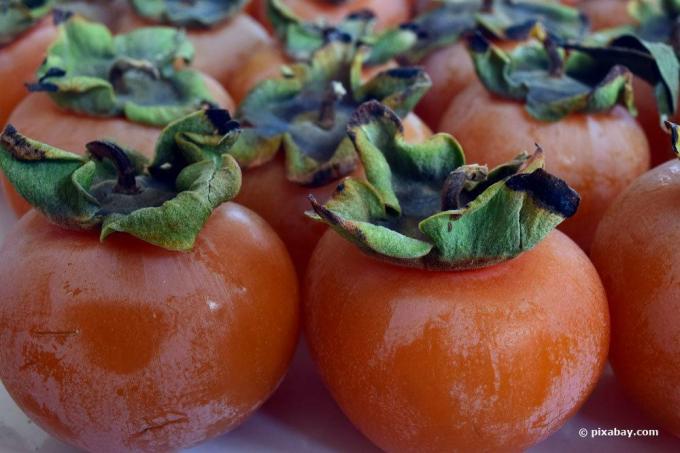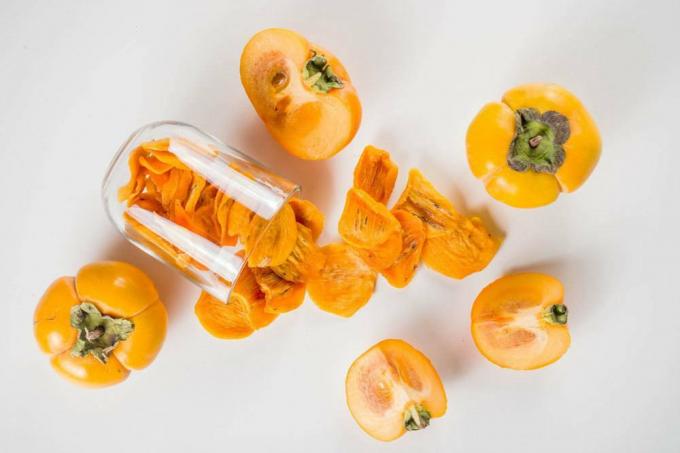
table of contents
- Persimmon or Sharon?
- Persimmon
- Persimmon
- Sharon
- Fruit ripeness and shelf life
- ingredients
The persimmon is one of the exotic fruits that are in season here, especially in the winter months. It is characterized by a round, tomato-like shape, which is also similar in color to the fruit vegetables. It can be confusing to find what appear to be the same fruits in stores as kaki, persimmon and sharon fruit. In fact, they are different cultivars that can be easily distinguished with a little practice.
Persimmon or Sharon?
The orange-colored, tomato-like fruit can be found on supermarket shelves, especially in autumn and winter. But are the different names really referring to the same fruit? Here you can find out all the differences to persimmon, persimmon and sharon fruit.
Persimmon
This berry fruit is originally from central China. It grows on trees up to 10 m high and belongs to the ebony family. Today it is mainly grown in Japan, Korea and China. Depending on the type of cultivation, the fruits are orange-yellow to red in color. There are also differences in the content of tannins. These tannins give unripe fruits a furry feeling in the mouth and a bitter taste. The more ripe the fruit, the more the tannin content decreases. The persimmon is the
original wild form of all similar varieties. When the persimmons are ripe, they are so soft that they cannot survive long transports, which is why they are often sold unripe. Further characteristics of the persimmons:- reddish-orange color, similar to a tomato
- only edible when fully ripe
- The pulp becomes jelly-like
- Solid peel is edible, but is usually not consumed
- Fruit is suitable for spooning
- owns cores
- mostly cultivar Tipo

tip: Real persimmons can be grown from seeds themselves, but depending on the cultivar, they are not frost-resistant.
Persimmon
It is not a separate species, but a Cultivar of persimmons. It is mainly grown in Spain. Persimmon naturally has fewer tannins and is therefore edible even if it is not yet fully ripe. The pulp does not taste as bitter and is sweeter than that of the persimmon. Since the bowl is not that firm, it cannot be spooned. Instead, it is simply eaten out of hand like an apple; the peel is edible. It can be recognized by its elongated, oval shape which has a light red color. Persimmons are also often harvested when they are not ripe. In order to reduce the tannin content, they are artificially ripened by treating them with the ripening gas ethylene.

Note: The firm pulp can be easily cut into pieces. Only the flower base needs to be removed before consumption.
Sharon
This cultivated form comes from Israel and is named after the Sharon plain, where it is still grown today. It is also cultivated in Spain, Italy and South America. It has no seeds and, like persimmon, is also edible if it is not yet ripe. Their flesh is very sweet and has little tannin. The taste is reminiscent of sugar melons. It is also stronger than the persimmon and therefore has a longer shelf life. The shape of the fruit is flatter and smaller compared to persimmons. The color is more yellowish than reddish. The Sharon can be eaten with the peel or, if you don't like the taste, you can peel it like an apple.

tip: Unripe Sharon fruits can be stored for up to 5 months, they are often artificially brought to full maturity.
Fruit ripeness and shelf life
All types of persimmons can ripen at home. However, they must not be put in the refrigerator for this. In a room warm place they develop into fully ripe fruits within one to two weeks. However, once they are fully ripe, they cannot be kept for long and should be stored in the refrigerator. They then last an average of two days, in exceptional cases up to four days. Persimmons can easily be frozen or dried. There are no differences between the individual varieties in terms of processing and use.
ingredients
The kaki, sharon fruit and persimmon hardly differ in their ingredients. All three varieties are very healthy and contain a lot of beta-carotene and vitamin C. This is especially true for fully ripe fruits.



